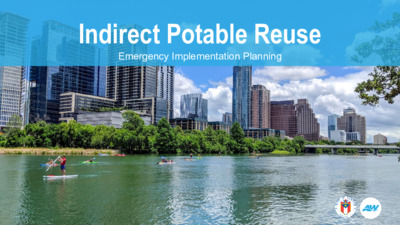4_Update_on_Indirect_Potable_Reuse_Emergency_Implementation_Project — original pdf
Backup

Indirect Potable Reuse Emergency Implementation Planning AGENDA IPR Project Update • Key progress to date and upcoming activities • Water quality modeling and permitting Emergency Supply Strategy Alternatives • Direct Potable Reuse Next Steps IPR PROJECT UPDATE WHAT IS INDIRECT POTABLE REUSE (IPR)? IPR is an emergency water supply strategy included in the 2018 Water Forward plan The strategy would use Lady Bird Lake as an environmental buffer and to convey highly treated WWTP effluent to Ullrich WTP for use in supplementing drinking water supplies Reclaimed water system New advanced treatment processes (SAR or Walnut WWTP) Lady Bird Lake (Ullrich WTP) Source: ensia.com/features/in-an-arid-u-s-west-water-agencies-look-to-delive%E2%80%8Br%E2%80%8B-purified- wastewater-directly-to-customers-faucets%E2%80%8B-despite-yuck-factor/ Full Storage Stage 1 Drought Trigger Stage 2 Drought Trigger Lowest Recorded Level Pro-Rata Curtailment/ Stage 3 Drought Trigger Stage 4 Drought Trigger* IPR Trigger 2.0 1.9 1.8 1.7 1.6 1.5 1.4 1.3 1.2 1.1 1.0 0.9 0.8 0.7 0.6 0.5 0.4 0.3 0.2 0.1 0.0 * Assumed 400KAF Stage 4 Drought Trigger for WF18 modeling IPR: PRELIMINARY PROJECT LAYOUT Tom Miller Dam T P PS Ullrich Water Treatment Plant Walnut Creek WWTP T P Longhorn Dam Conveyance of Reclaimed Water – Walnut Creek WWTP Alternative Conveyance from Intake Pump Station to Ullrich WTP Conveyance of Reclaimed Water – South Austin Regional WWTP Alternative South Austin Regional WWTP T P KEY PROGRESS TO DATE Nov. 2022 Feb. 2023 Initial regulatory discussion with TCEQ Consultant rotation list procurement begun September 21, 2023 Plummer NTP issued; Water quality modeling begun December 5, 2023 Internal IPR working group formed Dec. 2023 – Feb. 2024 Plummer continued updating 2016 EFDC (flow dynamic) and WASP (water quality) modeling January 19, 2024 Internal AW IPR Emergency Implementation February 23, 2024 TCEQ informal meeting on preliminary water quality Workshop modeling UPCOMING ACTIVITIES February – June 2024 Design engineer procurement March – July 2024 Refinement of emergency water supply implementation plan Summer 2024 WF24 evaluation of emergency strategies Coordination with ongoing permitting activities WATER QUALITY MODELING & PERMITTING Initial model was developed in 2016, modeling the period from July 2012- December 2013 Plummer updated the modeled period to January 2018 – December 2022 Includes flows from period of record (EFDC hydrodynamic model) and water quality data (WASP model using both measured and reference values) Purpose of modeling is to provide TCEQ with updated Ladybird Lake baseline conditions and understand how various effluent constituents behave • Primary concern is nutrients contributing to the growth of algae, because the lake is on the EPA 303D list of impaired waters for excessive algae EMERGENCY SUPPLY STRATEGY ALTERNATIVES REUSE AS AN EMERGENCY SUPPLY IPR and DPR in Emergency Implementation Context https://www.susana.org/_resources/documents/default/2-551-wintgens-hochstrat-2006-d19-integrated-reuse-aquarec-en.pdf REGULATIONS: IPR VS. DPR Indirect Potable Reuse (IPR) • Compliance with Clean Water Act (Texas Pollutant Discharge Elimination System [TPDES] permit) • Compliance with Safe Drinking Water Act (at water treatment plant [WTP]) • Water rights - City must have right to divert and use water Direct Potable Reuse (DPR) • Texas Commission on Environmental Quality (TCEQ) guidance focuses on compliance with Safe Drinking Water Act • Treatment requirements based on source water (effluent) characterization • Approval via exception process REGULATORY PROCESS- IPR- DISCHARGE PERMIT Develop water quality model Evaluate potential permit limits Submit application for major amendment of TPDES permit to TCEQ TCEQ review and public notice process TCEQ issues amended TPDES permit with outfall to Ladybird lake Typical permitting timeline is 1-2 years TCEQ DPR GUIDANCE- DPR FACILITY APPROVAL PROCESS Perform wastewater effluent characterization Submit a pilot-scale study protocol Conduct the pilot-scale study and prepare a report Submit the pilot-scale study report Submit a full-scale verification test protocol Submit a disinfection protocol (“CT Study”) and test parameters to verify membrane performance Construct the DPR Plant Submit plans and specifications for the DPR plant Startup the DPR plant, conduct the full-scale verification test, and prepare a report to summarize results Submit the full-scale verification test report Expected timeline is minimum of 4-5 years POTENTIAL TREATMENT COMPONENTS: IPR VS. DPR IPR DPR • Existing treatment and potentially: • Chemical addition for phosphorus removal • Effluent filtration • May require additional nutrient removal at wastewater treatment plant (WWTP) • Low pressure membranes • Reverse osmosis (RO) • Dechlorination at outfall • Additional disinfection • May require additional treatment at the drinking water treatment plant • Other processes pending detailed evaluation • Disposal of RO concentrate CITY OF WICHITA FALLS- FROM EMERGENCY DPR TO IPR CITY OF WICHITA FALLS - FROM EMERGENCY DPR TO IPR NEXT STEPS • • Consultant (Plummer) to continue: • • • • LBL IPR water quality modeling in advance of further conversations with TCEQ Development of Emergency Water Supply Implementation Plan AW IPR working group to: Continue coordination on key permitting activities, and communications and emergency implementation planning • Move forward on procurement of IPR design engineer and development of IPR configuration(s) Continue evaluation of emergency supply strategy alternatives Thank you!